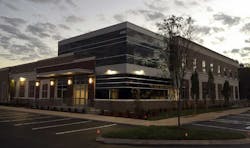Peak 10 is one of the most experienced players in the data center sector, having built its first facility in Jacksonville in August of 2000. With new leadership, the company is ready to move beyond its home markets in the Southeast and begin building a national footprint.
“Peak 10 has begun to position itself more broadly in the national data center conversation,” said CEO Chris Downie. “We’re very focused on identifying new markets and new opportunities. Our footprint is clearly focused on the Southeast, but our customer reach is very much national. We have the opportunity to add more facilities and customers.”
Downie was previously the CEO of Telx, where he guided the interconnection specialist in a national expansion prior to its acquisition by Digital Realty in 2015. After a short break from the business, Downie began looking for new opportunities in the data center sector.
That led to Peak 10, which is now owned by private equity firm GI Partners. Downie took the helm as CEO in September 2016, with co-founder David Jones shifting to Chairman of the Board.
“I recognized I was very bullish on this space,” said Downie. “It’s good to be back at it.”
New Platform Plays Emerge
His timing is fortuitous. The surge of investor interest in regional data centers has been one of the industry’s big developments of 2017. Several regional providers have new owners seeking to grow through additional acquisitions, including DataBank, 365 Data Centers and Cologix.
This emergent interest in second-tier markets also creates opportunity for established players like Peak 10, which has an experienced team and a parent company with the resources to compete.
Peak 10 operates 16 data centers in 10 geographic markets, with 2,300 customers and 860,000 square feet of space. Downie says that portfolio is supported by a “strong back office” that will enable Peak 10 to scale its operations.
The Peak 10 data center campus in Tampa. (Photo: Peak 10)
Downie moved quickly to begin building, and building bigger. Peak 10 has historically focused on data centers in the 15,000 to 50,000 square foot range, depending on the market. Its newest purpose-built data centers in Nashville and Tampa are 85,000 to 100,000 square feet, with 50,000 square feet of sellable space.
“It’s incumbent on us to build bigger environments that our customers can grow into,” said Downie. “Peak 10 has clearly shown that it can add incremental capacity in key markets. Our form factor is much larger than a decade ago. I’m a firm believer that you don’t want to cede opportunity to the competition by not having capacity. Atlanta, Nashville and Charlotte offer a different market dynamic now.”
Several Paths to Growth
Peak 10 will also be entering new markets, and is positioned to either build or buy.
“We’ll want to try and leverage the ability to expand dynamically into second-tier markets,” said Downie. “You’ll see us continue to push further north, and push out west. We have an opportunity to continue to focus on a couple of greenfield builds per year, based on our cash flow. From a brand extension basis, geographic adjacencies to our current markets make sense.
“But I’m trying not to limit our opportunity,” Downie added. “I don’t think there’s anything that keeps us from going into Dallas or Phoenix, for example. I think scale now affords us the opportunity to go into these Big Six markets and not be concerned about competing.”
The ongoing industry consolidation may also offer a path to expansion for Peak 10.
“From an M&A perspective, there’s clearly a lot of opportunity,” said Downie. “With GI as a partner, you can imagine that we’ve looked at a lot of these deals. We’ve explored many of these situations. We’re squarely focused on the retail side of the business. A number of the opportunities have been more focused on wholesale.”
Building the Interconnection Business
One area where Downie’s experience will help is interconnection, which in recent years has emerged as an important differentiator in the colocation market. Telx was one of the leading players in the interconnection market, where Equinix is the clear leader.
About 65 percent of Peak 10’s customers use colocation services, while about 20 percent are cloud customers and 15 percent use managed services.
Peak 10 has nine to 12 carriers in its facilities at present, which Downie said was a “fairly dense and robust service offering.” Even so, he sees potential upside. Nevertheless, he sees room for improvement.
“You’ll see a lot more form us on the connectivity front,” said Downie. “Building network utilities into the data center environment should be a leading consideration. I view it as critically important.”






